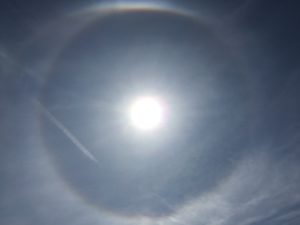Last week there was a ring around the sun for much of the day. This ring is called a halo and is caused by ice crystals interacting with sunlight.
A halo is a whitish ring that encircles but does not touch the sun. It can also have some color; the most discernible is a faint red tint around the inside of the halo. It is an optical phenomenon that owes its existence to the bending of light by ice crystals, much like the “rainbow crystals” you may hang in your sunlit windows.
The most commonly observed halo is the 22-degree halo. This halo encircles the sun at about a hand’s width from the center of the sun, if your arm is fully extended. Small column-like ice crystals form the halo. Light rays enter a crystal, bend or refract, and then refract again as they exit the crystal.
Because the crystals are randomly oriented in space, there are many different directions from which light rays can enter the crystals. Because of the optical properties of ice, more light rays are refracted at a 22-degree angle than at any other, producing the concentration of light known as the halo.
If you were lucky, you may have seen shiny, colored regions at either side of the sun. These are called sundogs, and are another optical effect caused by refraction.
Sundogs appear because ice crystals in the shape of hexagons drift downwards, oriented parallel to the ground. The sunlight passing through the crystal refracts and exits the crystal’s side face and generates the sundog.


